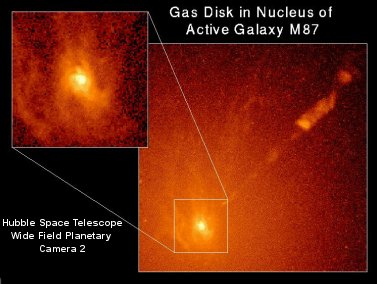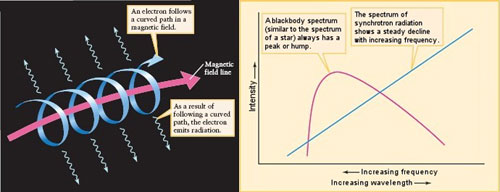Chapter
25. The Unified Model of Active Galaxies
25.1 Introduction
AstroTutorials
true
To advance to the next page of the tutorial you need to submit every question; currently you have not finished all the questions on this page. Leaving a tutorial page without submitting all the questions results in you receiving no grade in the gradebook.
true
Author: Scott Miller, Pennsylvania State University
Editor: Grace L. Deming, University of Maryland

Credit: Holland Ford, Space Telescope Science Institute/John Hopkins University
The goals of this module: After completing this exercise, you should be able to:
- Describe the observational characteristics of blazars, quasars & radio galaxies.
- Explain the unified model and how it explains each type of active galaxy.
In this module you will explore:
- The spectra of various types of active galaxies.
- How changing our view of an active galaxy causes it to appear as a blazar, a quasar, or a radio galaxy.
Why you are doing it: Active galaxies, such as the one pictured above, at first appeared strange and different from most of the galaxies we knew. They could be shaped like spirals or elliptical galaxies, with some similarities but a few important differences. It is important to understand how one model can explain most of the features of active galaxies.
25.2 Background

An artist's rendition of the center of an active galaxy, with jets being emitted perpendicular to the accretion disk surrounding a supermassive black hole.
The invention of radio astronomy by Grote Reber in 1936 soon led to the discovery of a number of new and strange objects in the sky. These objects were very strong radio emitters, yet appeared to be very far away from us; some of the most distant objects in the universe. Their spectra were different than normal galaxies, which emit thermal spectra due to the presence of their stars. (To learn more about thermal spectra, take a look at the activity "Spectra and Kirchhoff's Laws.") The spectra from the radio sources appeared to originate from nonthermal sources; objects that emit light for a reason other than they are hotter than their surroundings.
The light emitted from these odd objects varied very quickly, implying that they were compact. How could we possibly figure out the nature of these very distant radio sources?
Question
25.1
zpmndLLp2G8RDstCdEtxXga4l8odZy7d69XTVqF0D35Ukv2AqtAwcdgsbRIPM444ZE3O8lQAM1a7ZQaOcJBaA59Q5tnhNKfjK3jY4sLlgCev6d2OwJSO2tNHrgqt8yt8ALUG3t/CDMDsV5wN/hY+ZauPuSYUSy5DikZh4Wmk1p2/oZZo3xhyB6AewZOVKH0tGiuxMQxx32vV++/fKZeENTMozO1NYba/+f7vN8xMhMMlAQc+7LFWxEB4Wt+aY8KdMmS9HODvpRkb9kVap1+b8+Gf3TdZj1jbN70FouGMGSPgHREEUinCPXLSIY68DofAlkTZqyilPdYf1hhLNK1ECJ1Vtl4=
3
Try again. Sound cannot travel through space - it needs something to travel through.
Correct. Spectra are usually presented with the vertical axis as brightness and the horizontal axis as wavelength or frequency.
Incorrect. Spectra are usually presented with the vertical axis as brightness and the horizontal axis as wavelength or frequency.
Summary
By the 1950's, astronomers also discovered that these bright radio sources were actually the centers of larger yet fainter galaxies, hundreds of millions of light-years away. Astronomers call galaxies with such energetic nuclei active galaxies.
They gave these galaxies names such as "blazers," "quasars," and "radio galaxies" based on their observed spectra and luminosity. But as time went on, astronomers began to wonder if these various galaxies might actually be the same type of object, just observed different ways. Thus, they began to search for a unified model that could explain the similarities and differences between the various active galaxies.
25.3 Blazars

BL Lac, a blazar located 900 million light-years from Earth, has unusual properties
The first blazar to be identified, BL Lac, is located in the constellation Lacerta. This is the designation for a star, since when BL Lac was named in 1929 it was mistaken for a variable star due to periodic change in brightness over a few-month period. It took another forty years for careful observations to reveal faint emission surrounding it, and Doppler measurements of its spectrum to tell us that this object is located on the order of a billion light-years away. For this and other blazars that far away to be as bright as they are in the radio spectrum, they have to be some of the most energetic sources in the entire universe, emitting as much energy as a thousand Milky Way galaxies. Further observations revealed that most blazars have faint emission surrounding them: these bright radio sources are located in the centers of much fainter galaxies.
The spectra of blazars are intriguing. Blazar spectra are nearly featureless (while absorption and emission lines are present, the main spectra of blazars are dominated by nonthermal radiation), unlike galaxies which have absorption spectra due to the combined light from all of the stars contained within them. Blazar spectra are the result of synchrotron radiation. Synchrotron radiation is produced by fast-moving electrons as they spiral around strong magnetic field lines. The spectra of blazars are very different from stellar spectra, and do not contain prominent emission or absorption lines.

Synchrotron radiation has a spectrum quite unlike stellar spectra
Question
25.2
3u1AhoMrHCfjtTxgF+I2LgKgBYbDtmVwR9Y5Y+wmWzrVpTnhEjTPHL/Vjy+Zl/wp+O/O7BpDXw9THms8kJ6V/8XwSaBHQR+AEYl8aI30vFp3cN9CH6u2Cy1wz/j/oQVm3jBD0BRtsWtfkbolcTMcVu+d9wEI3NWDU09dftwiWAmpBpHConukbU2N7GGhF6lqTunDmt6NgUk1SVmjOj6Q5dkCftDh0cPnGGsFRDDbojTWT9MnqtnUhTm18ma2W/RibCJEAjtvoSKbpHveo6rsi8Oh93dqcmcC9IHCPMtSDu6nqHUQWaqnLOOHVJZc71obz6EmOTqBeZzrn7fGNMBtrFbwAR6nQHEO5XYVOUNzUNkbYPXBiAuLgkJN3gbRzIwdqpPYI5wGIz0XGk0nteOazjdeM3g=
3
Try again. Looking at the figure above, synchrotron radiation is strongest at the longest wavelengths. Add the intensity of the thermal spectrum to it. Which of the three ranges offered will have the highest intensity?
Correct. Looking at the figure above, synchrotron radiation is strongest at the longest wavelengths. When the thermal light is added, this results in the highest intensity.
Incorrect. Looking at the figure above, synchrotron radiation is strongest at the longest wavelengths. When the thermal light is added, this results in the highest intensity.
25.4 Radio Galaxies
In 1936, Grote Reber detected a number of strong radio emissions from a variety of sources. While some of them originated from within our Galaxy, one source proved to be a mystery. In the constellation of Cygnus, this object became known as Cygnus A (shown above). Located 740 million light-years away, Cygnus A gives off as much energy as 10 million Milky Way galaxies.

Cygnus A, an interacting galaxy located between a pair of enormous radio lobes, which are generated by jets emitted from the center of the galaxy, is one of the most energetic radio sources in the entire universe!
Question
25.3
rM+fdeppJhHNQjgUEOSEPoqzk3sL1FRGDp7PNw06Hca+NuRgtmixJuNjVehvvzJmpGKRUhn99S9sWC5KeeB8/yAkGwIX4YnWojGFgrldobN9B7S6jrwo6U01HYO7cC1b7QZJ3uX9+NzsNdbGjhvmO5Cg7qBSqdVgQhyL9+zI0BdG08MOCYE4HGvsykn4mmxf7mA85ekLQWIOGlBSOyXPMz+xwg8=
3
Try again. A light-year is the distance light travels in a year. Based on how far away Cygnus A is, how long has its light been traveling?
Correct. 740,000,000 years. A light-year is the distance light travels in a year. If Cygnus A is 740 million light-years away, then it must take its light 740 million years to reach us. That means what we see now is how Cygnus A looked 740 million years ago!
Incorrect. 740,000,000 years. A light-year is the distance light travels in a year. If Cygnus A is 740 million light-years away, then it must take its light 740 million years to reach us. That means what we see now is how Cygnus A looked 740 million years ago!
Summary
Astronomers detect synchrotron radiation similar to that emitted by blazars from these radio galaxies, as they've become known. In addition to the featureless spectra of synchrotron radiation, astronomers have discovered narrow emission lines.
Another fascinating feature of radio galaxies is the presence of jets emanating from the nuclei of these galaxies. As seen in the figure above, these jets can plow through intracluster material, slowing down as it does, and in the process, giving off energy at radio wavelengths, creating huge radio lobes on either side of the galaxy. These lobes can extend out to a distance 5 - 10 times the size of the central galaxy, and cover a region millions of light-years across.
25.5 Quasars

3C 273, a bright quasar 2 billion light-years away.
As astronomers examined more and more bright radio sources at great distances, they discovered another class of radio objects. Observations of these sources (such as 3C 273) showed that, like blazars and radio galaxies, these objects are extremely far away. In fact, they are among the most distant objects observed in the universe, on the order of billions of light-years away. Astronomers called these objects quasars (or quasi-stellar radio sources) due to their large radio output and starlike appearance. Similar objects, found at large distances and starlike in appearance yet having little or no radio emission, have also been detected. Astronomers now distinguish between the two by the terms radio-loud quasars and radio-quiet quasars.
Quasar spectra suggest that they also aren't galaxies. Their spectra are characterized by broad emission lines, indicative of rapid, turbulent motion within the energy-emitting region. Also, quasars emit more ultraviolet light than normal galaxies. In the 1980's, astronomer determined that similar to blazars, quasars are the bright centers of much fainter galaxies. Radio-loud quasars are typically found in elliptical galaxies, while radio-quiet quasars are also in ellipticals, but are in some nearer spiral galaxies.
Question
25.4
RkFzZHXiDrexZCuxQT+CoxzjT+YzJTgs1oCqJXFo1mdbEskXxDJTMfJL37uuTVSwEjxUpGXUkPnkf4vHCvyN06zMMr1s0bZcNA8Tm2h7PtFg+VU2eC3ynG6RZKNU36pWuJYbZzjQV/EPt13SyQahjb30B0yu4/EYMlI7UEy/4QQlPuqmAZ4rXTcXBxutt/C7I8OVtBCKbWABu8oPyaoTXjiJDZJK59iML1MXHum1vjlavmX6sgxLRG9CWcmf3JkIAuP/8PuRnA9/x4fGjNZNl7xrduKBptfXiQ+4NvTlbj9YrX5GkgxlffblHoXx82Yaby3zI2866Z7nnI/GpfYC5BmzeC8uEmXCF+Tzna5AV/MjCcHm0mHwbUxfcFltGs4y4jvkgrCnWrOE76zWbKcEGqD/EBr0BH3aAq5SM2vXvKXqPkn44LhRtChx92j+EDrKxaBm8wwNKt56MYGG29cjfMx1etExkBIs7lFtC1KFXbJMmhjmc57XfcdqA/rHYIMSZ7zVRAU54d21IcfNQ30rmoJkmzq59/nh9qfwKPeIvLohsTgItas22aGH2QgN2L/GPmSgiMnxhUvw9Id3t4guObj2947MRlDS2k0fxhbPzHpBw7HWKkm4OhWF+e1wmR74eCKhftj9NqXid/9u0hsR5IBX7OwM99YaX8Ok1BNaQrLhKDNOeFXLF3qY8ss=
3
Try again. Looking at the figure above, synchrotron radiation is strongest at the longest wavelengths. Add the intensity of the thermal spectrum to it. Which of the three ranges offered will have the highest intensity?
Correct. As a blob of gas moves toward us, it emits light that is slightly blueshifted. Another blob of gas moving away from us emits light that is slightly redshifted. The net result is the production of broad emission lines.
Incorrect. As a blob of gas moves toward us, it emits light that is slightly blueshifted. Another blob of gas moving away from us emits light that is slightly redshifted. The net result is the production of broad emission lines.
25.6 A Unified Model
With the discovery of different types of active galaxies, yet all with similar characteristics, astronomers began looking for a connection between the various active galaxies. The images below demonstrate the model that astronomers believe unifies the various active galaxies; suggesting that they are all active galactic nuclei, driven by a central supermassive black hole seen from different angles.
The images above show a supermassive black hole with an accretion disk surrounding it, giving off jets perpendicular to the disk. Depending on how the accretion disk and jets are oriented relative to our line of sight, we either see the jets coming straight towards us or we see them at some angle.The series of images show the possible orientation angles and you can see how a change in view of the galaxy can alter how we perceive it.
When the jets of energy are pointed directly towards us, we detect a nonthermal spectrum void of emission or absorption lines, indicative of blazars. Fast moving electrons are spiraling along the magnetic field lines, which spiral outward perpendicular to the accretion disk. The magnetic fields focus the charged particles into the jets of energy that we observe. When they are pointed directly towards us, we detect mostly the synchrotron energy given off by the electrons.
As our angle of observation increases we now observe the turbulent accretion disk, whose rapid rotation produces broad spectral lines in addition to thermal radiation from the disk and synchrotron radiation from the jets. This is consistent with observations of radio-loud quasars (if no jet is present the observer would see a radio-quiet quasar). When we look at the accretion disk close to edge-on, the torus or doughnut shaped region surrounding the black hole obscures our view of the accretion disk. We can see emission from hot gas rising out of the accretion disk, but its spectrum is neither blue- nor red-shifted, and so we detect narrow emission lines. In addition, we still detect the synchrotron emission from the jets. Combined, this leads us to detect the galaxy as a radio galaxy.
Question
25.5
tlFMXTBTNFm6Eq2b6unmWULwYzjGSygRWbwnJ9tqfSIpfTNUBuZX3LVT3sMSE75yqIIaD5rreMEg2IrzzHGJRQEQltWAZvbSWlhauc10LgrvHOplHpxdm10g/Hk7dNxqp+r2Cr7rzGhosACP0VfPCUDDnCSA9Mp5NHpqjSLtRDeN7vkv6GYfcUtKLSfYyy1mjMWBbX/s4Qxwf5r/H493AlHmTAQ=
3
Try again. Active galaxies are one example of a group of astronomical objects that have different observed characteristics and were initially not thought to be related to each other.
Correct. As far as astronomers can tell, most of the observational data we have for blazars, quasars and radio galaxies can be explained using the unified model of active galaxies.
Incorrect. As far as astronomers can tell, most of the observational data we have for blazars, quasars and radio galaxies can be explained using the unified model of active galaxies.
Summary
What started out as observations of a range of strange and exotic galaxies has turned into the collection of a group of objects that essentially are all the same. Most differences between blazars, quasars and radio galaxies can be explained simply by the fact that we are looking at similar objects, just from different perspectives. The unified model not only provided insight into these fascinating active galaxies, but also gave us a greater understanding of how galaxies behaved in the early universe.
25.7 Quick Check Quiz
Indepth Activity: The Unified Model of Active Galaxies
Question
25.6
oh1JmXunoy5v7BrKwgdnBxQ9BH3MCSXHwXBAG6JlLB4VC1F7yzQ4JXh0ixFn6kf5n86do3TJ5pgSEGhzM7PefxUQ7RlEEeD/zqFdDWKC5c2VBK6Ht+vYavghNZ6utgzEIOmIrLiLwXG7rJmQEOx5NMsNvM13SevR7EcGQY+Mb2GRD8UZ9uV8zMDpt8ExJKJoKEEZ8reD5vfyD7T2xZM/dUcg7vQcmO+/alyVRWun5h+YgbZYrFItnMNNYjOQg8RcHoSeaQJ/KNeSCKEdCOBjyIVXHRMv2auNELYMnFFYDgUjlyiKa78xxYNdj70+6RF543iab3XSBKZIzP5F2Mtvx0648hsLOc2UzbtJ5M1tY3WrISlEpHSwOJvi/p4nAReyAuCrgIUtvVYXyDzFK5eP0hcjrV5WZQBzW/8NxA==
Correct. Normal galaxies have thermal spectra due to stellar emission while active galaxies have nonthermal spectra due to synchrotron radiation.
Incorrect. Normal galaxies have thermal spectra due to stellar emission while active galaxies have nonthermal spectra due to synchrotron radiation.
Question
25.7
Fyc1N+Sy7q6JrVpi9UE40/Lkine6NkReQOLtxqIIfOYTL6ge5C7gXqlPQuJF+nUuFUhL/D4kxZ6rGMbCZUHSw1FggGoyjgM+2eMHEpZ7jYCRxlUVSHIwRp68nCY4o4DVjt4W53N1RiCr9p2zgM3mMI7pL0BHo9zwPk79YxDq0cmmVPRUbsRxVlMd5k6Wof+8DyR+u79DDWSTbj/eF8Nb6dApopU+5YzExmAr5yc9hdwmMBroFjaXiOAU8B47d0I9/S8m6i6vmMr3UbBQ5BnkrLy0dMXfigrIT3/2BYqtLgUWvb0Wv9Kze2RkSbb78ZqQkGbprhB7jVh0UEMQ9fcZcFXF9ZAUyw3UTmU/K+psrMoqCha1l+RZHla3DSKqm9uRuU4fQystBTYis7x3vZkkzK7J7ofKr5v9SkB5Ym2OPrszW8UiCO5ElUZlHVBZfdA/mK9zlRLYj2jqgpEASTFZW9GT4hWFKgAtwlFxnTrsnKgtgFeSCTC+hGxzmaLOnYG3
Correct. Active galaxies are classified as such because they have large energy output in the nucleus of the galaxy. In many cases the remaining galaxy is too faint to be observed, relative to the bright nucleus.
Incorrect. Active galaxies are classified as such because they have large energy output in the nucleus of the galaxy. In many cases the remaining galaxy is too faint to be observed, relative to the bright nucleus.
Question
25.8
uCbHwSOjngqIN+U7ru7Dm2qOeinVwXE56NTOWttFR7xemD0v+1swzIOvDt6oLdl7WIX2hJmC1A3PivSuazN2u/e1psikdQEyUWN9kjHlUhr+GNoL7A7wU3/7GSz0oHf+xTiMpN1PRlnwHV/Cw7UNfhz+UwRbJrZepGXt3yEr54E/U8U830igmj3Hck7JYzYnFcK6QLdH8uiLItRh
Correct. As the turbulent gas in the torus moves, emission lines are broadened due to the Doppler-shifting of the light emitted by various blobs of gas in it.
Incorrect. As the turbulent gas in the torus moves, emission lines are broadened due to the Doppler-shifting of the light emitted by various blobs of gas in it.
Question
25.9
B0MUMFrhs9MKHlFwUTlSnG4U4DiMNAhy9Q19ptaOMWVhECCvoOZhb1h3pwQestHaZAS2DZ+2HuNIx2o8lln+cpWrWR0V78Oe/H4haH4QiZmqpShujiEPis5oNc/PvOTUuBlNeHrnCnP7mcxY4koIpRKoT6hUTDyJPCF9g/RiO4tAwub501LLBZ0W+6KclbQmR49t5g==
Correct. As jets coming from the galaxy encounter nearby interstellar gas, they create the huge radio lobes. When we observe an active galaxy as a radio galaxy, we are observing the jets being emitted nearly across our line-of-sight, making it easiest to see the radio lobes.
Incorrect. As jets coming from the galaxy encounter nearby interstellar gas, they create the huge radio lobes. When we observe an active galaxy as a radio galaxy, we are observing the jets being emitted nearly across our line-of-sight, making it easiest to see the radio lobes.
Question
25.10
A3UiPBy6/ScZcpLGOoUNMaXXrTRblYxrrj3Yn/0ROHeHN/iLlmbJIKQixQf52GcGz34yCSxwYcImvq7S00leoJpmZZkcas4gFyvs2hGVvSwilT2kjV87Ptdp5EOMAH+fCLXxD0v5kQepICCYgndS4yXveVMw+I4ZMfU5U5RCJbFXmXMoLZsB1F4wXC71kl/G8AIZhitJV7H3otC/i0IHn1mU0A+Cm4eZAHCvUTIiDwwDOPpa/qcxTR5PV3H06NMHxSJEBHTcw681fukA2mkM5q/4PKOzkRTWFj+xnd2seCUnTd8p4BSt9xjdZse1VIrVTjdNkopEQqDWmRzFmgRmYeHGrloWaNcg8vw1XLmSm/RsIUsbqBW4PM/mONg0KcuJMeLAJDDvl1JAY63DGGvB6z7FN7vXH3YAO1ElEdJO5i5Rw2xuBcBZ17lUo7x78W3BIsbz0BHhSBDw28z/rwbuDZ5j9W+6gxMiRDtxmscbUpEk9ha51av88Je74DmUG7JMFgaUwrK+hX71mxvyw1eIFP71ta0MC7Z4c1DX3vlHnV/S2js+c3F0rtfsnXtFHOcH6IZ322co5R4Z8xiZyqA0sP+gJGj5qIa8FObTLZXkuWrc7QvtRmv5NQ==
Correct. The invention of radio astronomy by Grote Reber in 1936 soon led to the discovery of a number of new and strange objects in the sky.
Incorrect. The invention of radio astronomy by Grote Reber in 1936 soon led to the discovery of a number of new and strange objects in the sky.
Question
25.11
PISIOu5UaSsP8sCRR4rbDFUXMBSu0v1RiAM/ZjVaw5DQamYG5w4i1ir1tvfipmgt2iagHUgXO2EZl5ZUXNY+uHMVE79AEzm0OuA6Xcil+Dkco7zb/wPpSThdAa86eQAysNNKvrHvk7mz1W5cq8lheyoCbAQ9tzDO80HCjb3f0nSWk+FdEbZ7E/u3Zndp3bqudwdra4W14oFzqf0yHn8PPpwO5SUKkrgzpe4YREHx0ZuwMM3RUEnfBjXqEVcrsKhIiSUpWw==
Correct. Robotic missions were crucial to the human missions to the Moon. Many robotic missions have been accomplished since the end of the Apollo program and more are being planned.
Incorrect. Robotic missions were crucial to the human missions to the Moon. Many robotic missions have been accomplished since the end of the Apollo program and more are being planned.
Question
25.12
nsRFt5SW/bjYO2vzIFVcoT38WJfeX62muJ4BvX7sgUDfDqiNX96z8UqFMFnH0WgCTlkqJb+kKXrX+pPlUG4vByz903HEwbJl6pS6b3zLPa/WSp74UHgB0NMAu+5CRUy0eclcnqmLY7ZZOSJJ+7vflVDWBcqRCK93y/G2bCYJwkDkx1qBuc6YsOPmGUU9o6vmMpWlG/XLwpkDWzP0PX9CF80BVfu8xz1Feh6UU2fXCu/6PxJwIWXvR4GnpUSz2OQqx20NorCUOWVHg4aR5Z/WXZBKXgY1/8B0YZ5/0lXa7letRlG4UKptqymYPUqkaxAm/JLnmvSRODh2GaWxTWyBIPiPzeVj5gZP8Xi86kN/D0nMFMphwknnOzn1gZ/3aEpOzsGK4Kxt6aAF8LRjZ6J4PUCZEu8dVg9rzTfaD8t7eXgh56H+6LIugwZn0g2pMCeSgqzrinAOl06Krd5ZJc1xXeAG//KoLgDT1X0qxVlEkBb9YtmTlsyhKdj0u6jsjAdGes6TTjHprBoL5vzsuGXJalh57Oo5lE3TIoF55g==
Correct. The light emitted from these blazars, quasars, and radio galaxies varied very quickly, implying that they were compact.
Incorrect. The light emitted from these blazars, quasars, and radio galaxies varied very quickly, implying that they were compact.
Question
25.13
hjLRlRYtLwODoWgdGS3ePcslc+ZqihS9/46OxWVcY3Vi6ZN2Jw8XS+7pw3WSxQTpPxQIVCyYIL+rZjiSa2PXCDgFC5vNnU05Bs7TapFIcI7pmlYsEQecFc2n5+aOFdxWLjiR9Sv814ek5bBwZqy67WhxTTFlRi43i9/GoiybcwxRb7WjKbZzijyqI6qN/nIhTmdrZv/+sAgmsSlm0OJXQcn6y1HBZ8pbgvBn6wIrH+jNKE+zZn/dFAotiBkuNj+aFqPumRFiHCKNYU9iA4zl/qUDUUaIrCA8EGuwemCqrQLhCKbSBKn3QOH1A188I+yv6dVEFUh5ikcdH+PhTgoXw+z1w6v3WJWn8dLDiP8FlJkFGADPQs6n7G0ACYblyli4mdO542jmxjnLe6JoE1s74oJqh+g=
Correct. The unified model not only provided insight into these fascinating active galaxies, but also gave us a greater understanding of how galaxies behaved in the early Universe.
Incorrect. The unified model not only provided insight into these fascinating active galaxies, but also gave us a greater understanding of how galaxies behaved in the early Universe.
Question
25.14
6tyzIeWrGAOy//TdgvsLiXycmsS38heqp/YrmG7wN4zomBEnuIT232zt0wshw1JI8OiLsVeVf/1gnKbKPUzgGq94VS32mONVWvPjrFOfCro50ybZ/m+8qRd0GanTOo/ajxCRY+o0DMrCM//OqfLQ1lFvZ9wExCR8Z5snsjTSXdJ9PxpFt0CCQD1EgRhnSjEDC5m2FZ8XDoymQUpv7BwPWgHSKmhkCHArgKtB9xWXsamXWOncuYdgKjmCZI2BRSqi5t8YUb/GwrbVIY4dXrRoynkjHo1oPhZxHPeENYIvBmTHQvcSuAkqCGjrve1B9v4+U/l2S4M52Hqa135roZ1Qb0aT3AJo3q48obxl/m+W+GIxhbn0PU/MnKkC7b57ODRewgEqa0hBffTvPXU9
Correct. When we look at the accretion disk close to edge-on, the torus or doughnut shaped region surrounding the black hole obscures our view of the accretion disk. We can see emission from hot gas rising out of the accretion disk, but its spectrum is neither blue- nor red-shifted, and so we detect narrow emission lines. In addition, we still detect the synchrotron emission from the jets. Combined, this leads us to detect the galaxy as a radio galaxy.
Incorrect. When we look at the accretion disk close to edge-on, the torus or doughnut shaped region surrounding the black hole obscures our view of the accretion disk. We can see emission from hot gas rising out of the accretion disk, but its spectrum is neither blue- nor red-shifted, and so we detect narrow emission lines. In addition, we still detect the synchrotron emission from the jets. Combined, this leads us to detect the galaxy as a radio galaxy.
Question
25.15
2NCme7vixNT/UZc8tiXG9NHy7zNF+jC614bfLTMKqQthY1EUhPMFBu1rOocd3uYL99UaOoZm6KIwaHIFUGqPDWZM4IU84JV4nZRcPHIOlt3BJZ18LWOiaSQ9WutIP9O+FpzHxSP04eGDlxcUPPrWAskw9GB1B1dV3vHhfiUNQFbPShfYuNCcCdqAWHwtFedDuIYJh7xXJ/MuYjEsxOT9WllA5ky2lWiSNYCM3T1bXznJpSZ3JR6i0KLcZ+y7xqZnDsBOljFOp+iM8l+S2/Cjfozk3qX56jbzk3npke8jTUU=
Correct. Blazars have almost featureless spectra due to the synchrotron radiation being beamed directly towards us, drowning out most of the other light from the active galaxy.
Incorrect. Blazars have almost featureless spectra due to the synchrotron radiation being beamed directly towards us, drowning out most of the other light from the active galaxy.






